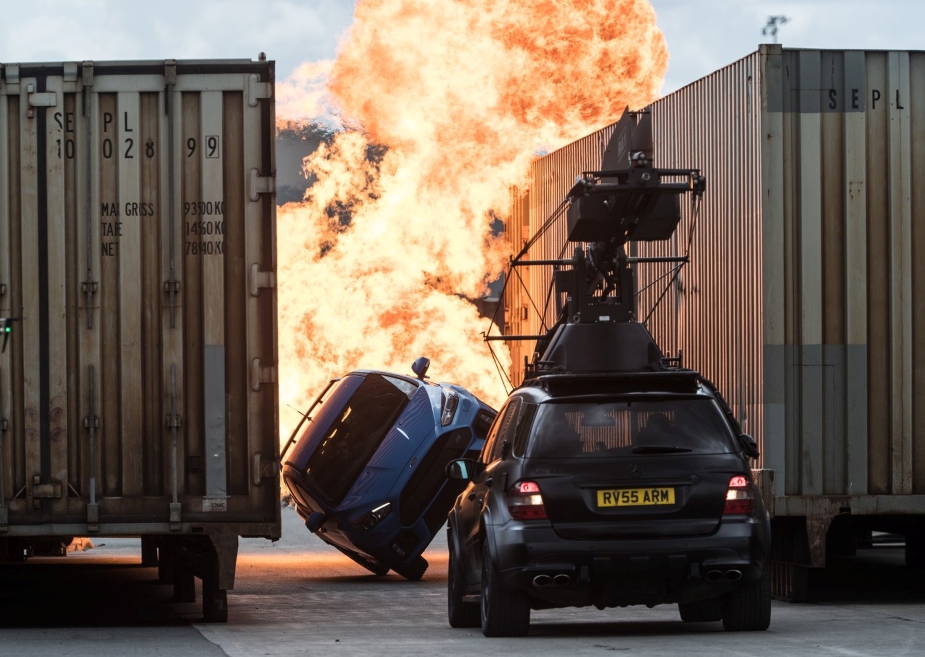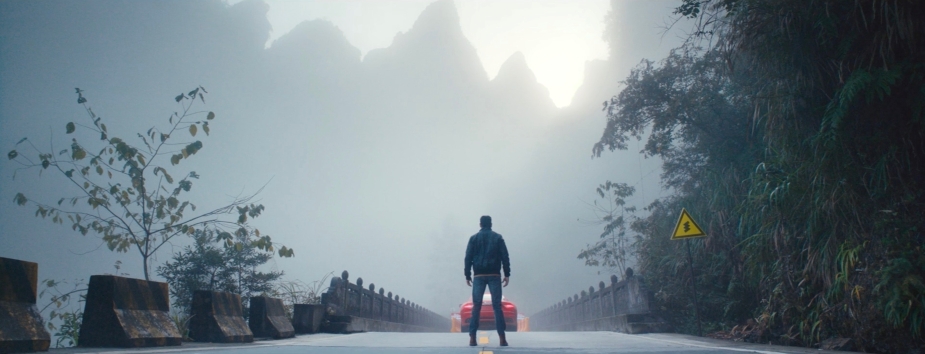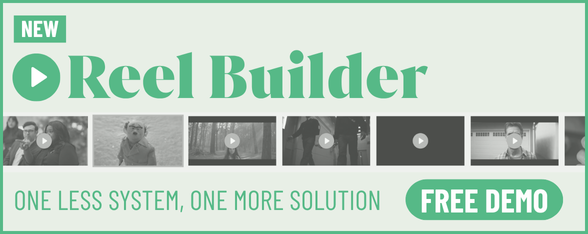
‘Top Gear’ Director Konrad Begg’s Limitless Pursuit of the Winning Shot

“I set my own bar very high and see every script as an opportunity to make something extraordinary.”
Adventurous, tech-savvy, and ever-evolving, Konrad Begg recently signed to production company, Annex, for exclusive representation outside of the USA. With recent work including a series of brand films for TripAdvisor featuring Olympic gold medallist Keely Hodgkinson, the prolific director has made everything from epic commercials and star-studded short films to acclaimed feature films, documentaries, and scripted drama.
Having also contributed over thirty episodes to the BBC’s hugely successful ‘Top Gear’, it doesn’t come as a surprise that automotive is Konrad’s specialty. For him, cars have always been more than machines, “they’re freedom, creativity, and connection.”
His second feature film promises to be “an epic road movie in the truest sense: a deeply emotional journey, thrilling stunts, and some very cool cars,” while his commercial portfolio is peppered with Campaigns for the likes of Ford and Nissan. Even within the genre, each film is impressively distinct, tapping into the unique personality of the individual project: “One spot might be about raw, visceral power – tyre smoke, speed, chaos. Another might lean into elegance, quiet refinement, or a single moment of emotional connection.”

These foundations, along with his experiments with AI and virtual reality, have placed Konrad at the cutting edge of filmmaking. “I often feel like I'm waiting for the tech to catch up with the ideas in my head,” he says. “Some of them are pretty radical, but I live for that moment when they become possible.” It’s that ideation stage that he finds truly intoxicating, a “phase state where nothing is fixed and every possibility is still alive. That initial rush, that feeling of limitless creativity – it’s like a drug. A very, very good drug. And I’m fully addicted.”
While the way he thinks and creates is in constant development, what remains consistent is his sensitivity to rhythm, composition, and emotional connection – what he describes as “reaching into the void, plucking out an idea, and bringing it to life in the hope that someone, somewhere, will respond.” In the end, he says, that’s what filmmaking is all about.
Ending his freelancing stint, Konrad is now on the hunt for new opportunities with the trusty team at Annex – the first people he reached out to because, in his words, life’s too short not to work with good people. “We’ve worked really well together in the past, and I’ve always liked the way they operate – calm, capable, and collaborative,” he reflects. “As a director, especially now, it’s crucial to be surrounded by a team that has your back and understands what you bring to the table.”
LBB’s Zara Naseer sits down with the Annex director as he embarks upon this next adventure, hearing his anecdotes from an action-packed career, wise words on the tech boom, and what a dream brief would be.
Above: Konrad's showreel
LBB> Your portfolio features stunning visuals and high-octane sequences, filmed everywhere from the backstreets of Shanghai to the Scottish Highlands. What are the furthest lengths you’ve gone to to achieve the winning shot?
Konrad> I’ve honestly lost count of the flights I’ve taken or the miles I’ve travelled in pursuit of that ‘winning shot’. I’ve hiked countless mountains, boarded some of the sketchiest helicopters you can imagine, bobbed around the Southern Ocean in a Force 8 gale, and even narrowly avoided a plane crash in Indonesia – all for the sake of the film. And every time, without question, it’s been worth it.
You have to be willing to push yourself – and your team – to the absolute limit sometimes. If you get the shot right, no matter how arduous the journey, everyone walks away happy.
On the day, I’m usually so hyper-focused on the job and caught up in the excitement of the moment – whether it’s a performance beat or a big stunt – that I don’t fully register the risk or the chaos around me. It’s only much later, when I see it edited into the final film, that I think, wow… That was actually pretty great.
There’s almost no limit to how far I’ll go for that one perfect shot.
LBB> Automotive is your specialty – what is it about the category that excites you?
Konrad> For me, there’s a kind of magic around cars. I’ve always loved road trips – the act of movement, the sense of possibility in a journey. Cars enrich people’s lives in ways that go far beyond the school run or commute; they’re conduits to freedom.
Some of my favourite films are road movies – ‘Midnight Run’, ‘Two-Lane Blacktop’, ‘Sideways’, ‘The Straight Story’, ‘Nebraska’. There’s something deeply special about sharing a car journey with someone – the conversations, the silences, the shared experience of the road. But there’s also a unique magic in being alone behind the wheel – just you, the car, and the road ahead – where every mile becomes a kind of moving meditation. I love all of that.
I’ve never owned anything exotic – just a pickup truck and a very old Land Rover Defender – but I deeply appreciate great design and engineering. Cars are where aesthetics and mechanics meet; where art and technology merge.
What excites me most is capturing and sharing that feeling – the joy of speed, the anticipation of the next bend, the horizon pulling you forward. It’s not just about horsepower, handling or, God forbid, load space; it’s about translating the emotional impact and the connection between car and driver into something that resonates with an audience.
Above: Ferrari Roma Spider 'Fascination'
LBB> Having contributed over thirty episodes to BBC’s ‘Top Gear’, has that experience impacted the way you approach automotive advertising?
LBB> Absolutely it has. Working on that show was a truly unique experience. We got to do some pretty crazy things, from elaborate car stunts to big, silly set pieces. It gave me an enormous amount of hands-on experience in both the precision and safety of stunt work, and the rhythm and timing of comedy. That balance – thrill and humour – is what still excites me today.
In between the laughter and the extremely hard work, I made great friends and found crews I still collaborate with now. When the show ended, the EP sent out a goodbye email. I won’t go into details, but the key takeaway was that the collective is greater than the individual. That’s stayed with me. Surround yourself with people you trust and respect, who are great at what they do, and as passionate about making great films as you are.
It also taught me that talent beats budget every time. A good eye is worth more than a truck full of lights and cranes. You learn to be creative with what you’ve got, to know where to spend and where to save. Often, a small, elite crew can achieve far more than a bloated unit of hundreds.
Finally, 'Top Gear' taught me the art of planning for spontaneity. This is how you achieve ‘authenticity’, something so many scripts require. The comedy and chaos felt improvised, but it was only possible because we planned for the unpredictable. We created space for moments to happen naturally. I still carry that philosophy across everything I do: commercials, drama, documentary.
LBB> When pitching for commercials, do you prefer to focus on your distinct, consistent style as a filmmaker, or your ability to shapeshift to fit the brand mould? How do you identify the right balance?
Konrad> When it comes to commercial work, I believe finding the right balance is an internal process. It’s not a question of ‘Do I stick to my style or bend to the brief?’ – it's about finding that Venn diagram overlap where the director’s vision and the client’s needs align. That’s where the strongest work happens.
Compromise is part of the process, of course, but there still needs to be a clear, confident vision driving the film. And fortunately, with the tools we have now – from look-books to animatics to AI pre-vis – it’s easier than ever to get everyone aligned early, long before cameras roll.
Scrutiny is healthy. Whether it’s coming from an editor, a creative director, or the client, that back-and-forth is where the best ideas often emerge. Sometimes you have to fight for a choice you believe in, but other times you need to zoom out, listen, and adapt.
Digging in too hard too early usually makes for a worse film. The goal is collaboration – not just compromise, but creative convergence. For me, that’s where the really great stuff lives.

LBB> Can you tell us about the work you’ve been doing with VR studios using Unreal Engine? What new frontiers have you been exploring?
Konrad> Last year, I had the opportunity to shoot at Robot Studios in Florida, using VR and Unreal Engine. The technology is powerful, but like a high-performance racing car, it only works if you have a skilled driver.
The options can be overwhelming (from the infinite background choices to dynamic lighting setups) so having a clear vision and strong pre-vis is absolutely essential. Lighting and staging work very differently in a virtual environment compared to location shoots, and it's definitely not something you want people figuring out on the fly.
Where it really shines is in projects involving embargoed products – like new cars or tech – where location shoots just aren’t feasible. It’s also incredibly effective for capturing talent in controlled driving scenarios. You can shoot ‘golden hour’ all day long, or move a mountain with a mouse click. That flexibility can be liberating, but also, in a way, soulless. I still love the unpredictability and texture of shooting on location. Each approach has its place. Virtual production is a fantastic tool – not a blanket solution – and it's all about knowing when and how to use it.
LBB> How will you be navigating the ‘flattening of culture’ that people are anticipating as a result of the AI boom? How can filmmakers embrace new tools to stay at the cutting edge, without going too far and falling over into ‘slop’?
Konrad> There’s this real concern about the ‘flattening of culture’ – everything becoming this hyper-optimised, bland sludge that’s been run through too many filters and avatar focus groups. And I understand that. The danger is we lose that raw, weird, human edge.
I think the job of any filmmaker – in any era or genre – is to expand imagination without diluting it. So yes I’m all for exploring new tools, but not at the expense of originality. Not if they turn storytelling into spreadsheet management. Once we start letting the data tell us what characters to cast and what arcs to write, we’re not making films, we’re just manufacturing ‘slop’.
That said, right now there are practical upsides. AI can help with things like storyboarding, cheaper CGI, and multi-language voice cloning – things that make production more accessible, or help translate a vision.
I’d definitely draw the line at certain things. Deepfakes, for instance, make me uneasy. They may have niche uses, but there’s a big risk in messing with people’s likenesses, especially when they’re no longer around to say ‘yes’ or ‘no’. There’s a fine line between tribute and exploitation. Equally, there is a purity and a spirit to real performances.
Brands and studios should be careful not to underestimate their audience – whether in TV, film, or commercials. At its core, it’s about trust and connection. When people are ill – even if an AI makes the correct diagnosis – they still want the news delivered by a human. People don’t want their lives entrusted entirely to an algorithm.
The same is true in our industry. Audiences instinctively trust a brand more when they can feel the presence of a person behind it. We’ve got to keep human weirdness (embrace the weird!), myth, emotion, and intuition at the core.
Above: Lego 'The Great Lego Heist' (Director's Cut)
LBB> You’ve had a celebrated career already, being recognised by BAFTA, the Emmys, and the Royal Television Society, but what’s been the biggest highlight for you?
Konrad> The moments that stay with me aren’t always the obvious ones. The real highlights are when something lands on a personal level – a message from someone saying a film moved them, the ripple of a live audience reacting in real time, or even just a perfectly timed laugh in exactly the spot you hoped it would happen.
I remember a screening at the ArcLight Cinema in LA. The theatre was packed, but I was too nervous to sit inside, so I hovered by the doors with a friend. Then suddenly there was this massive laugh from the crowd. That sound… It was indescribable. I just turned to my producer and said, “Right, that’s it – let’s go celebrate.”
Then during lockdown, we made a pretty hard-hitting short film that ended up screening at festivals around the world. It even premiered at Mann’s Chinese Theatre in LA. Because of travel restrictions, we couldn’t be there – which was gutting – but then I started getting emails from other filmmakers and attendees saying how it made them feel. That meant just as much as the ArcLight experience.
There have been other moments like that – Andy Murray tweeting about my ‘Marauder’ film, or Simon Cowell buying an Eagle Speedster after seeing it on ‘Top Gear’. You think, ‘Alright, maybe we’re doing something right’. And as a film maker – that’s a good feeling.
All of that said, my first BAFTAs will always be special – especially as I went with Robbie Coltrane. He was brilliant company, incredibly funny. We drank whisky and then lost to a show about hillwalking or something. Perfect.
LBB> What’s your dream brief?
Konrad> My dream project would be a series of car spots that make electric vehicles genuinely cool – giving them personality, attitude, and the same emotional pull as classic cars. The magic, the spirit, the real joy of driving.
The concept would pay homage to iconic road movies like ‘Two-Lane Blacktop’, ‘Thelma & Louise’, ‘Vanishing Point’, and ‘Badlands’, blending their spirit with contemporary talent to bridge past and present. I’d want to shoot in multiple visual styles – ‘90s, ‘60s, ‘30s – the more the merrier!
I’d aim for a game-changing spot – something that gets people talking, like Paul Street’s classic Steve McQueen piece for the Ford Puma, which turned an everyday car into an icon. The goal: excite the petrolheads, win over the 'Top Gear' crowd, and make them feel the same rush for an electric car that they do for a ’70s muscle machine.
At the heart of it, I’m chasing real moments: the magic that makes a film more than the sum of its parts. Any brief that starts with the ambition to truly move an audience has me hooked from the very first conversation.
Above: TripAdvisor starring Olympic champion, Keely Hodgkinson















